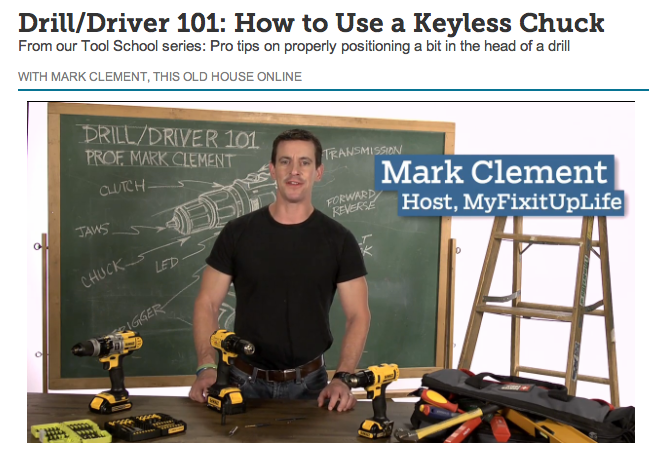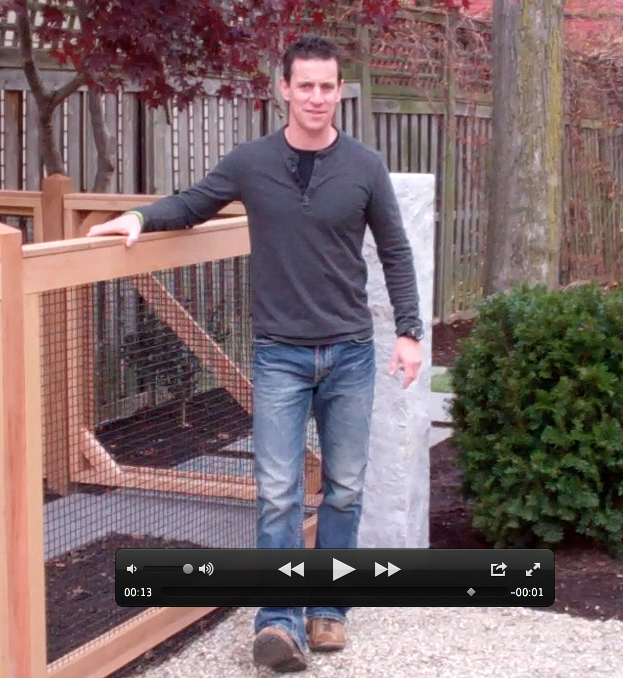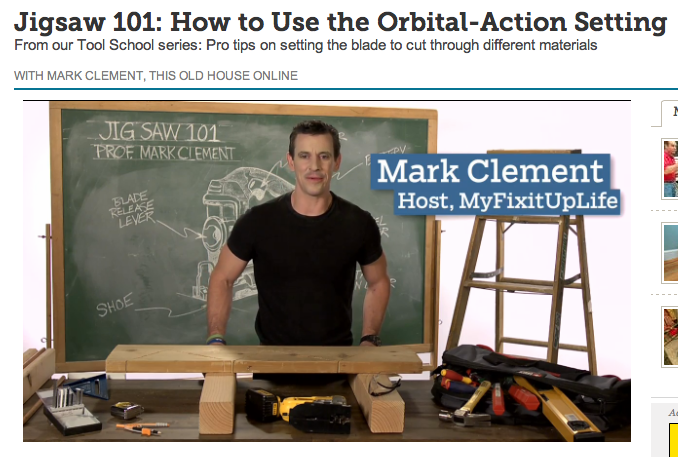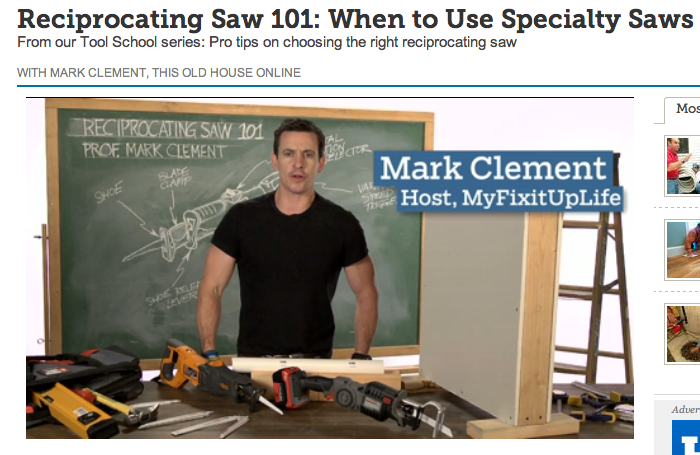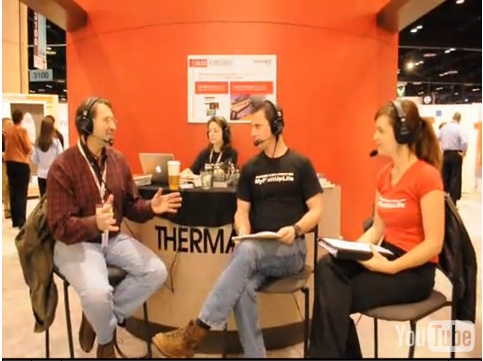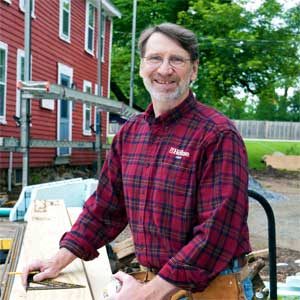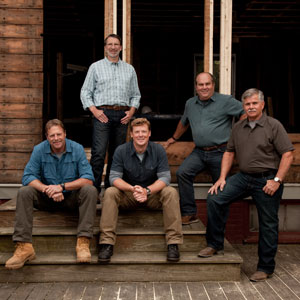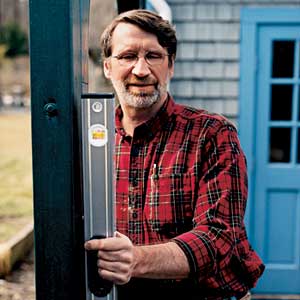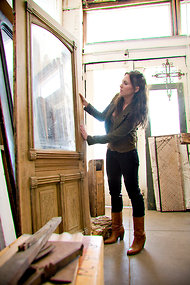
Mark: You are back inside MyFixitUpLife with my wife Theresa.
Theresa: And my husband Mark.
Mark: A very old house and two extraordinary contractors from This Old House, Roger Cook and Tom Silva.
Roger: My husband, Tom.
Tom: What’s up?
Mark: Those questions are on this side of the paper. Moving on.
Theresa: Yes. We just got a hand from being quieter.
Roger: That’s because they’re filming upstairs.

Theresa: We have to be more gentle, you have to be gentle. Use your inside voices.
Mark: Let’s use golf voices.
Theresa: Yeah, library voices.
Roger: I don’t golf.
Mark: Tom Silva steps up to the 18th hole, skips it, goes to the 19th hole and opens a beer.
Theresa: Insert bird noises.
Mark: Guys, let’s start with Roger because Roger you’re right to my right here. What were the landscaping challenges on this project starting with the impossible landscaping challenge, moving to easy?
Roger: It’s Cambridge and you never have enough room to do anything. The thing I have to consider is Tommy has to come in here for eight months and he needs room to do his stuff, so then I get two weeks to come in here and finish everything. That’s just the way it is and it works because we do this together. About a month ago, he started giving me space on the site so I could start working my way around the site. It’s a strange dance we do and we pull it off every time.
Tom: Yeah, it’s about a foot a day. In 30 days he has 30 feet, but that’s how it works.
Roger: We don’t work fast. We work well, but we don’t work fast.
Mark: Is it, I guess, is it harder the smaller that a site is?
Tom: Oh yeah, absolutely.
Roger: Yeah, every square inch counts on a small site. On a big site you can put down a lot of mulch, a lot of grass, but every square inch is so vital on a site like this that that has to be all taken in into consideration on the plan that you’re working with.
Mark: Then, where you move things, where you move to, back, forth, all this other stuff?
Roger: Yeah, half the stuff’s still at my house, so we’re bringing in the rest of it in the spring. We’re good for now.
Mark: As it turns out, we could use some plants.
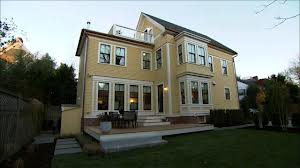
Theresa: I have to say when I walked onto the property I felt very calm, like it feels very, I don’t know, meditative or something like that. Walking around everything’s so dense. It’s a very bustling neighborhood, and then walking onto this property I just want to go outside and have a cup of tea and relax. Is that the feeling you had too, honey?
Mark: That’s exactly it.
Theresa: Cup of tea?
Roger: Yeah, beer tea.
Mark: Yeah, yeah.
Roger: It’s a compliment to the landscape architect, Greg Lombardi. I think he did a great job with the materials we put in and the way things transitioned from different rooms, but also the physical things we took care of. The down spouts, the drainage, and all the stuff that you don’t see, the preparation, all Tommy’s work on the deck and all the way around the house, it really came together. It will be a really nice project.
Tom: The landscaping did really come out very nicely, as it always does. The division with the plants and everything it really separates the driveway to the private area and the deck. The bushes that you did out front are really swell because it separates, it gives them their space, but it’s not tight.
Mark: No and when it comes to landscape structures like decks, it looks like there’s a garden outside, like a food garden. I don’t know what it is.
Roger: Oh yeah, there is.
Mark: It’s a fenced structure. You guys worked together on that? Tom, you build it and do you plan it and that kind of thing?
Roger: It’s sort of a repeat of something we’ve done three times this summer. We find that people are really getting into their vegetable gardens, and the only thing you can do is fence it off or the woodchucks or someone finds it, the deer or the rabbits. It’s a duplicate of what we did. What Tommy did, and it was a great cost saving measure, originally, we were going to have a stone wall and a raised blue stone deck out back, and that was going to cost a lot of money. In fact, it would’ve blown the budget, but Tommy came up with the idea of rebuilding the deck a little bit and then putting these Ipe square grids on top of it. It worked out great for what they need.
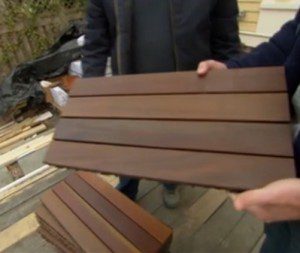
Tom: Have you guys seen those? It’s basically a mat system that the Ipe boards, [inaudible00:04:09] ipe, mahogany. They even have tile or slate and they’re attached to this grid system, so that they’re either 12 x 12 or 12 x 24, and it’s an interlocking system that if you have a concrete patio, for example, and you want to make it wood, you just lock this system together and it can go on in a pattern that we’ve placed outside which is basically just a straight pattern, no staggered joints. You could herringbone it or you could do …
Mark: You can change them.
Tom: You change it. You do a brick wall, running board, all kinds of different things that you could do with them, or you can use the squares and alternate the squares. Again, you can do it in slate or granite. They have different…
Mark: I know oversimplifying it, is it just lying there sort of like a floor system?
Tom: You aren’t oversimplifying it. It’s very simple. It’s basically put it in place, take the next one, put it beside it, snap down on it, and it’s in place.
Roger: Hit it with your hand.
Theresa: Really?
Tom: It’s very easy.
Mark: Its own mass keeps it there. So, even I could install it?
Tom: Its own mass keeps it there.
Roger: It sits off the ground just a little bit. It’s great because it drains very well too. It also adapts. We did it on a concrete thing for Ask This Old House, and it will adapt to a little bit of deviation. It’ll move a little bit, so it’s good.
Tom: Yeah, because there’s legs underneath it. We did over the pressure treated deck that was here.
Mark: You left the frame.
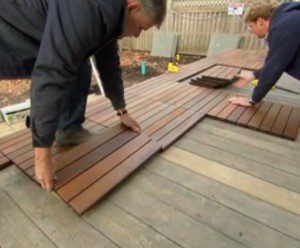 Tom: We left the frame and the pressure treated decking. I repaired some of the decking that was really bad and I wanted to make sure that it was straight, so I dug out a couple of pieces. I also drilled a series of holes through the decking so I’d get better drainage. Other than that, I put it right on top deck, saved a ton of money.
Tom: We left the frame and the pressure treated decking. I repaired some of the decking that was really bad and I wanted to make sure that it was straight, so I dug out a couple of pieces. I also drilled a series of holes through the decking so I’d get better drainage. Other than that, I put it right on top deck, saved a ton of money.
Roger: Yeah, he did. It was a great idea.
Mark: From a critical path standpoint, when you guys are walking a job site and you’re talking about you need to get material in but you have certain jobs you need to do, do you frame from the inside out, do your rough carpentry that way?
Tom: It depends on the job. In this particular job, this particular house, there was minimal work done to the exterior of the house, although there was a lot of work, I would say in most jobs that we do this was a minimal exterior job. We didn’t replace the siding. We patched some of the siding. We didn’t put in new windows. We installed replacement windows against the existing trim, casings. In some of the cases where I had to move windows or where they had a new window, for example, they had a new window that was shorter in the kitchen, so we didn’t have an old window that would fit there, so what I did is I took older window parts like the casing and the sill, I cut them down, I put them into place. Then, I took a new double hung replacement window and put it behind it.
Mark: My wife is glowing with the ingenuity.
Theresa: You’re a building artist. That’s what you are. You’re an artist.
Tom: Thank you.
Theresa: I’m just saying that that’s now your title. Just go with it. Roll with it because the creativity, the ingenuity…
Mark: She doesn’t glow that often. That’s a whole…
Theresa: I’m impressed. There are lots of synapses firing when you have to think about those different things.
Mark: I’m going to get in trouble for this later, but nor is she usually that quite.
Theresa: No.
Tom: The thing is I grew up in an old house built in the late 1700’s, and I learned my trade as a very, very young person. I was probably four or five years old. I was always working alongside my dad. He was always renovating and restoring a house that he lived in on weekends and at nights. It was five little boys running around because it was four brothers and a sister. We used to drive him crazy. I thought I was working with my dad. He basically said to my mother one day and he said, “These kids are driving me crazy. They’re right on top of me. I’m going to buy them tools. I’m going to tell them they’re toys and I’m going to put them to work.” He put me to work at a very early age, but I loved it. I loved it.

Mark: Roger, were you conscripted into childhood labor as well?
Roger: No, no, no. I really fell into this business. I majored in forestry in wildlife management in college and had a job for the summer after I graduated. That got done in August. My wife informed me I would find a job, a real job, right away, said ok, and I ended up working for a landscape company. My first job was pruning the ivy around the windows at Harvard University. I lasted about three days and I said, “This just isn’t for me.” The boss said, “Do you want to work?” I said, “Yeah,” he put me out on a construction crew and I learned how to run backhoes and do paving. For five years, I was a happy camper. I loved what I did, and then I left and started my own business.
Theresa: Wow.
Roger: The great part of the story is the company that I started for was the original landscape company for This Old House, so I got to meet all the people. Five years after I left and started my business I got a call from Tom Worth, he was the landscape architect on the original shows we did, saying, “Do you want to work with This Old House again?” I said, “No way.” No, just kidding. I said, “When,” and he said, “Tomorrow.” I said, “I’ll be there,” so that was it.
Mark: Nice.
Roger: Long time ago.
Mark: Nice. You’ve done everything from hardscaping to taking down trees to lawn maintenance, right?
Roger: Oh yeah. I first started out I had two little 21-inch mowers out of the back of my Jeep and I’d drive around to the clients houses, I think they just felt sorry for me at the time, and cut their lawns, but it was kind of crazy.
Mark: Sounds familiar.
Tom: You got to do what you have to do.
Roger: You did, didn’t you? Whatever it took to get by?
Tom: That’s right, that’s right.
Mark: My mom’s car was my first vehicle.
Roger: Is that right?
Mark: Yeah, car.
Theresa: Yeah, yeah.
Mark: I’m not even going to tell you what kind of car it was.
Roger: I stole my father’s string trimmer because I couldn’t afford to buy a string trimmer.
Mark: Now you’ve risen to this, but we’ve risen to having to take a break.
Theresa: We do.
Mark: We’ll be back from the set of This Old House wrap party, 34th season, with more of MyFixitUpLife.

